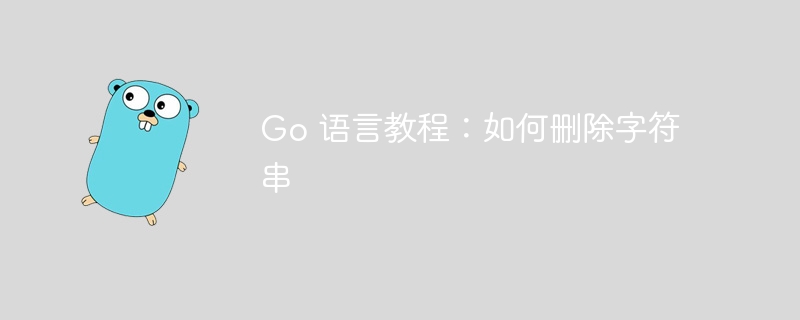Go language tutorial: How to delete a string

The Go language is an open source programming language. Its design is inspired by the C language and aims to provide an efficient programming experience and a powerful tool set. In Go language, string is one of the common data types, and deleting a specific part of the string is a common operation. This article will introduce the specific operation method of how to delete strings in Go language and provide corresponding code examples.
First, we can use the Replace function in the strings package to remove a specific part of the string. The prototype of this function is:
func Replace(s, old, new string, n int) string
where s is the original string, old is the part to be deleted, and new is the empty string , n is the number of deleted patterns. The following is a sample code:
package main
import (
"fmt"
"strings"
)
func main() {
str := "Hello, World!"
deletedStr := strings.Replace(str, "World", "", -1)
fmt.Println(deletedStr)
}In the above code, we remove "World" from the original string "Hello, World!" and print the result. -1 means delete all matching parts.
In addition to using the Replace function, you can also use slicing to delete specified parts of the string. The following is a sample code:
package main
import "fmt"
func main() {
str := "Hello, World!"
startIndex := 7
endIndex := 12
deletedStr := str[:startIndex] + str[endIndex:]
fmt.Println(deletedStr)
}In the above code, we first calculate the starting index and ending index of the part to be deleted, then use slicing to remove the part to be deleted, and print the result .
In short, the Go language provides a variety of methods to delete specific parts of the string, and developers can choose the appropriate method according to actual needs. I hope the code examples provided in this article can help readers better understand how to delete strings in Go language.
The above is the detailed content of Go language tutorial: How to delete a string. For more information, please follow other related articles on the PHP Chinese website!

Hot AI Tools

Undresser.AI Undress
AI-powered app for creating realistic nude photos

AI Clothes Remover
Online AI tool for removing clothes from photos.

Undress AI Tool
Undress images for free

Clothoff.io
AI clothes remover

Video Face Swap
Swap faces in any video effortlessly with our completely free AI face swap tool!

Hot Article

Hot Tools

Notepad++7.3.1
Easy-to-use and free code editor

SublimeText3 Chinese version
Chinese version, very easy to use

Zend Studio 13.0.1
Powerful PHP integrated development environment

Dreamweaver CS6
Visual web development tools

SublimeText3 Mac version
God-level code editing software (SublimeText3)

Hot Topics
 What libraries are used for floating point number operations in Go?
Apr 02, 2025 pm 02:06 PM
What libraries are used for floating point number operations in Go?
Apr 02, 2025 pm 02:06 PM
The library used for floating-point number operation in Go language introduces how to ensure the accuracy is...
 What is the problem with Queue thread in Go's crawler Colly?
Apr 02, 2025 pm 02:09 PM
What is the problem with Queue thread in Go's crawler Colly?
Apr 02, 2025 pm 02:09 PM
Queue threading problem in Go crawler Colly explores the problem of using the Colly crawler library in Go language, developers often encounter problems with threads and request queues. �...
 In Go, why does printing strings with Println and string() functions have different effects?
Apr 02, 2025 pm 02:03 PM
In Go, why does printing strings with Println and string() functions have different effects?
Apr 02, 2025 pm 02:03 PM
The difference between string printing in Go language: The difference in the effect of using Println and string() functions is in Go...
 How to solve the user_id type conversion problem when using Redis Stream to implement message queues in Go language?
Apr 02, 2025 pm 04:54 PM
How to solve the user_id type conversion problem when using Redis Stream to implement message queues in Go language?
Apr 02, 2025 pm 04:54 PM
The problem of using RedisStream to implement message queues in Go language is using Go language and Redis...
 What is the difference between `var` and `type` keyword definition structure in Go language?
Apr 02, 2025 pm 12:57 PM
What is the difference between `var` and `type` keyword definition structure in Go language?
Apr 02, 2025 pm 12:57 PM
Two ways to define structures in Go language: the difference between var and type keywords. When defining structures, Go language often sees two different ways of writing: First...
 What should I do if the custom structure labels in GoLand are not displayed?
Apr 02, 2025 pm 05:09 PM
What should I do if the custom structure labels in GoLand are not displayed?
Apr 02, 2025 pm 05:09 PM
What should I do if the custom structure labels in GoLand are not displayed? When using GoLand for Go language development, many developers will encounter custom structure tags...
 Which libraries in Go are developed by large companies or provided by well-known open source projects?
Apr 02, 2025 pm 04:12 PM
Which libraries in Go are developed by large companies or provided by well-known open source projects?
Apr 02, 2025 pm 04:12 PM
Which libraries in Go are developed by large companies or well-known open source projects? When programming in Go, developers often encounter some common needs, ...
 When using sql.Open, why does not report an error when DSN passes empty?
Apr 02, 2025 pm 12:54 PM
When using sql.Open, why does not report an error when DSN passes empty?
Apr 02, 2025 pm 12:54 PM
When using sql.Open, why doesn’t the DSN report an error? In Go language, sql.Open...






